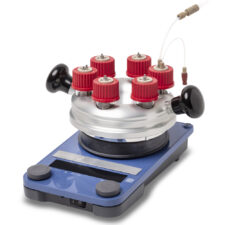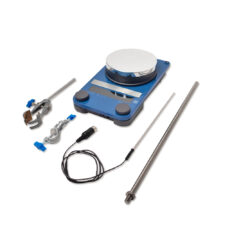Electrochemistry involves the application of a voltage driven by an external device across a pair of electrodes in contact with liquid reactants. The electrical potential induces electron transfer between the electrode and the reactants, thereby stimulating a chemical reaction.
The ElectroReact is Asynt’s electrochemistry series reactor
Types of Electrochemical Reactor:
The choice of the reactor is important for the success of electrochemistry. Electrochemical cells can be undivided, where the flow of electrons is uninterrupted between electrodes, separated, typically by an ion permeable membrane or run in series to create an electrochemistry series reactor.
A well characterised reactor which is capable of operating under inert conditions when required, allows easy sampling or addition or material and most importantly one which enables the control key factors such as electrode material, spacing and mixing will give the most reproducible and reliable chemistry.
A selection of electrode materials
Variables in an Electrochemical Reactor:
When setting up an electrochemistry reaction there are a few variables to consider:
- The nature of the electrode
- The voltage or current applied across the electrodes
- Whether the chemistry is performed on the anode or cathode
Why use Electrochemistry:
Electrochemistry applications enable the unique activation of reactants and transformations that can be difficult by other means. The main application in organic chemistry, REDOX reactions, reduces the quantities of toxic and hazardous reagents and as the reaction is “reagentless” allows for greener chemistries.
The ElectroReact with a potentiostat
Why use Electrochemistry:
Electrochemistry applications enable the unique activation of reactants and transformations that can be difficult by other means. The main application in organic chemistry, REDOX reactions, reduces the quantities of toxic and hazardous reagents and as the reaction is “reagentless” allows for greener chemistries.
Applications of an Electrochemistry Reactor:
- Oxidation and Reduction Reactions: Every electrochemical process involves an oxidation reaction (at the anode) and a reduction reaction (at the cathode). The electron flow between electrodes will drive the desired chemical transformations, so understanding this will be key to your chemistry.
- Electrolysis: Electrolytic cells are commonly used for electrolysis, a process that splits compounds into their constituent elements. A well-known example is the electrolysis of water, which separates it into hydrogen and oxygen gases.
- Electroplating: This involves coating a material, often a metal, with a thin layer of another material by depositing ions from a solution onto the surface. Electroplating is widely used in manufacturing, jewellery making, and electronics for corrosion resistance, decorative purposes, or improving surface properties.
- Compound Decomposition: Electrochemical cells can be used to decompose chemical compounds into simpler substances. This is particularly useful in the recycling and recovery of elements from complex mixtures.
A small, 5 mL electrolytic cell with PEEK electrode holders and ports for sampling, additions and a reference electrode at the top
Key Things to Consider When Setting Up Your Electrochemistry Reactor:
- Choosing Electrodes: The electrode material you choose will depend on the type of reaction and the chemical environment within your reactor. Common electrode materials include stainless steel, platinum, and carbon (usually graphite or glassy carbon), each offering different properties such as conductivity, reactivity, and stability. Some processes might require inert or reference electrodes. Asynt can provide a wide range of electrode materials. Often with more expensive materials such as platinum, a foil can be wrapped around a PEEK electrode holder.
- Reference Electrodes: In many electrochemical experiments, it’s important to include a reference electrode, which provides a stable and known potential against which the working electrode’s potential can be measured. Common reference electrode materials include silver and silver chloride. Reference electrodes ensure accurate monitoring and control of your system.
- Potentiometry and Cyclic Voltammetry: Potentiometry involves measuring the potential difference between two electrodes, while cyclic voltammetry measures the current that flows through a system. Both are useful techniques for analysing electrochemical systems and understanding the dynamics of a reaction.
Conclusion:
Modern electrochemistry tools such as the ElectroReact provide a wide array of chemistry opportunities and have helped unlock this important technique to a wider range of chemists. Asynt’s ElectroReact provides this in a compact, affordable and user friendly electrochemical reactor that makes for an excellent tool for anyone looking to start research into the field of electrochemistry.
If you’d like to know more about the ElectroReact or our range of electrodes don’t hesitate to get in touch via the live chat in the bottom right of the page, or by email ([email protected]) or phone (01638 781709).











